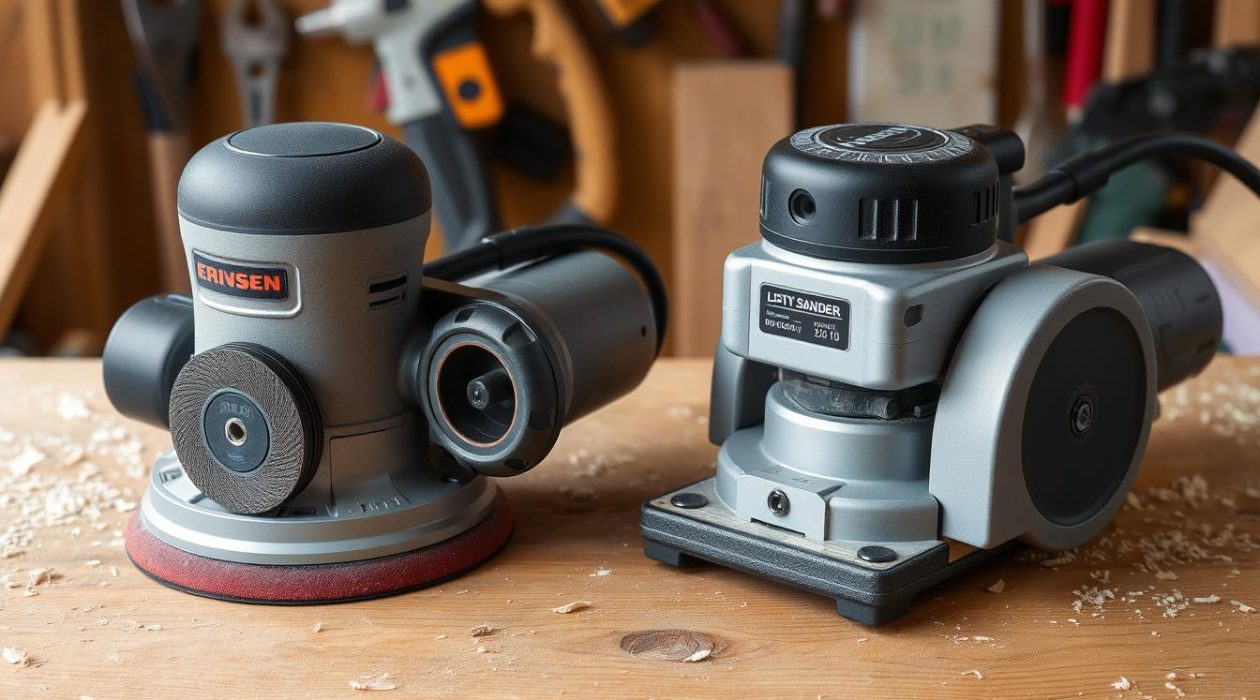Choosing the right power sander is crucial for woodworking and DIY projects. A thorough sander comparison is necessary to find the best tool for your needs. This article will explore the key aspects of orbital and belt sanders, including performance, applications, and cost.
An introduction to power sanders is vital for those looking to enhance their projects. The right tool can lead to professional-grade results, while the wrong one can result in subpar finishes. We aim to guide you in selecting the perfect sander, covering sander comparison and the basics of power sanders.
Key Takeaways
- Understanding the differences between orbital and belt sanders is crucial for choosing the right tool.
- A sander comparison can help you determine which tool is best suited for your projects.
- Introduction to power sanders is essential for achieving professional-grade results.
- Orbital and belt sanders have unique applications and uses.
- Cost and performance are key factors in a sander comparison.
- Choosing the right sander can make a significant difference in the quality of your projects.
Understanding the Basics of Sanders
Sanders are crucial in woodworking, with orbital and belt sanders being the most used. Knowing their basics is key to effective use. This includes their designs and primary uses.
Sanders are essential for smoothing surfaces in woodworking. Orbital sanders excel in fine sanding and polishing. Belt sanders, on the other hand, are ideal for heavy-duty sanding and removing old finishes.
When selecting sanders, consider their speed, power, and dust collection. Orbital sanders are perfect for finer work, like sanding small surfaces or polishing metal. They use finer grit sandpaper. Belt sanders, used for coarser work, require coarser grit sandpaper.
What is an Orbital Sander?
An orbital sander uses a circular motion for sanding. It’s great for fine sanding and polishing, ideal for small to medium-sized projects.
What is a Belt Sander?
A belt sander employs a continuous sandpaper belt for sanding. It’s perfect for heavy-duty sanding, suited for large projects needing significant material removal.
Key Differences at a Glance
When deciding between orbital and belt sanders, consider these differences:
- Speed: Orbital sanders are slower than belt sanders.
- Power: Belt sanders are more powerful.
- Dust collection: Both types collect dust, but belt sanders produce more.
Understanding these woodworking tools’ basics helps in choosing the right sander for your projects. This ensures the best results from your sanding efforts.
Power and Performance Comparison
When it comes to DIY sanding tips, the right sander is crucial. We’ll compare orbital and belt sanders, highlighting their strengths and weaknesses. Each sander is designed for specific tasks, making them essential for various projects.
The speed and sanding area are key in the performance comparison. Orbital sanders work at lower speeds, ideal for fine details. Belt sanders, with their higher speeds and larger areas, are better for heavy tasks. For instance, the Festool orbital sander has a 5-inch sanding area, while the Makita belt sander covers 4 x 24 inches.
When deciding between an orbital and belt sander, consider these points:
- Speed: Orbital sanders run at 10,000-12,000 orbits per minute, while belt sanders reach 1,000-1,500 feet per minute.
- Sanding area: Orbital sanders have smaller areas, perfect for detailed work and fine sanding.
- Project type: Orbital sanders are great for furniture making and wood finishing. Belt sanders are better for heavy tasks like deck building and floor refinishing.
By understanding these differences and following DIY sanding tips, you can choose the right sander for your project. Always prioritize safety and use the appropriate sander for the best results.
| Sander Type | Speed | Sanding Area | Project Type |
|---|---|---|---|
| Orbital Sander | 10,000-12,000 orbits per minute | 5 inches | Fine sanding, detail work |
| Belt Sander | 1,000-1,500 feet per minute | 4 x 24 inches | Heavy-duty projects, deck building, floor refinishing |
Applications and Best Uses
In the realm of sander comparison, pinpointing the perfect application for each sander is essential. Orbital sanders excel in fine finishing, ensuring a surface ready for painting or varnishing. In contrast, belt sanders are built for heavy-duty tasks, ideal for stripping old finishes or smoothing out wood.
Within the domain of woodworking tools, the selection of a sander significantly impacts outcomes. For instance, an orbital sander is the go-to for fine-tuning surfaces in furniture restoration. Yet, a belt sander is more effective for tackling large wooden decks.
- Fine finishing for furniture restoration
- Sanding small, intricate wood pieces
- Preparing surfaces for painting or varnishing
Conversely, belt sanders are best suited for:
- Heavy-duty sanding for large wood surfaces
- Removing old finishes or paint
- Sanding down rough wood for construction projects
Cost and Value Analysis
When deciding between orbital and belt sanders, cost comparison is key. The initial cost is just the start. You must also consider the expense of accessories, upkeep, and repairs. To maximize your sander’s value, adopting DIY sanding tips can save you money and time.
Here are some critical points to ponder when assessing the cost and value of orbital and belt sanders:
- Initial purchase price: Orbital sanders are generally cheaper than belt sanders. Yet, the cost of accessories and maintenance can escalate over time.
- Accessories and maintenance: Belt sanders often need more belt replacements, which can up their total cost.
- DIY sanding tips: Employing the right techniques and materials can enhance your sander’s performance. This reduces the need for expensive repairs.
By weighing these factors and conducting a detailed cost comparison, you can make a well-informed choice. Remember, the value of DIY sanding tips should not be overlooked. They can significantly help in saving money and time in the long haul.
Maintenance Requirements and Longevity
To keep your woodworking tools, like orbital and belt sanders, in top shape, following maintenance tips is key. Regular cleaning and proper storage are vital for their longevity. Always unplug your sander before cleaning to avoid accidents.
For cleaning and storage, use a soft brush to remove dust and debris from the sander’s surface. Store it in a dry area. It’s also crucial to inspect for damaged or worn-out parts and replace them quickly. You can find replacement parts and accessories, such as sanding belts and orbital sander pads, at hardware stores or online.
Some extended life techniques for your sanders include:
- Regularly checking and replacing the sanding belt or orbital sander pad
- Using the correct type of sandpaper for your project
- Avoiding overheating, which can damage the motor
By adhering to these maintenance tips, you can extend the life of your woodworking tools. This ensures they continue to perform at their best. Always consult your tool’s user manual for specific maintenance instructions.
| Tool | Maintenance Tip |
|---|---|
| Orbital Sander | Regularly clean the dust container and check for worn-out pads |
| Belt Sander | Check and replace the sanding belt regularly, and ensure proper tension |
Safety Features and Considerations
When working with power sanders, prioritizing safety precautions is crucial to avoid accidents and ensure a smooth project. Dust protection is a key aspect of safe sanding. Always wear a dust mask and safety glasses to shield yourself from debris and dust particles.
Electrical safety is another critical factor. Make sure your power sander is properly grounded and keep it away from water and moisture. Following DIY sanding tips for proper handling techniques is also vital. This includes holding the sander firmly and keeping your fingers away from the sanding surface.
Here are some additional safety tips to keep in mind:
- Always read the manufacturer’s instructions before using a power sander
- Wear protective clothing, including gloves and a long-sleeved shirt
- Keep children and pets away from the work area
- Regularly inspect your power sander for damage or wear
By adhering to these safety precautions and DIY sanding tips, you can ensure a safe and successful project. Always prioritize your safety and the safety of those around you.
For more information on power sanders and safety features, consult the manufacturer’s website or consult with a professional.
| Safety Feature | Importance |
|---|---|
| Dust protection | High |
| Electrical safety | High |
| Proper handling techniques | Medium |
Professional Tips for Maximum Efficiency
Choosing the right tool for your woodworking project is crucial. A sander comparison can guide you in selecting the most suitable option. Understanding how to use orbital and belt sanders effectively is key to achieving a flawless finish. With the right techniques, you can also extend the life of your tools.
Here are some essential tips to enhance your sanding process:
- Always start with a coarse grit and progress to finer grits for a smooth finish
- Use the correct sanding pattern to avoid scratches and swirl marks
- Keep your tools well-maintained and store them properly to extend their lifespan
By adhering to these professional tips and selecting the appropriate tools, you can elevate your woodworking projects. It’s important to consider the specific requirements of each project. With dedication and practice, you can refine your sanding skills, resulting in exquisite, high-quality pieces.
Common errors to avoid include applying excessive pressure, which can harm the surface, and neglecting to switch grits, leading to an inferior finish. By steering clear of these pitfalls and applying the suggested strategies, you can achieve a professional-grade finish. This will maximize the efficiency of your woodworking tools.
| Tool | Best Use | Tips |
|---|---|---|
| Orbital Sander | Fine finishing and detail work | Use a light touch and work in small circles |
| Belt Sander | Heavy stock removal and rough sanding | Apply moderate pressure and use a steady, back-and-forth motion |
Environmental Impact and Dust Collection
When sanding, environmental considerations are paramount. Sanding can produce a lot of dust, posing risks to both the environment and human health. To lessen these impacts, adopting DIY sanding tips that are eco-friendly is vital.
Effective strategies to cut down on dust and enhance environmental stewardship include:
- Utilizing a dust collection system to curb airborne particles
- Ensuring proper ventilation in the workspace
- Opting for sanding tools and materials that prioritize environmental concerns
Adhering to these DIY sanding tips and focusing on the environmental effects of sanding can significantly reduce ecological harm. It also fosters a healthier work environment.
Further, employing a dust collection system enhances air quality and shortens cleanup periods. This approach not only aids the environment but also boosts productivity and efficiency. By emphasizing environmental considerations and applying DIY sanding tips, individuals can positively influence the environment while achieving their sanding objectives.
| DIY Sanding Tips | Environmental Benefits |
|---|---|
| Using a dust collection system | Reduces airborne particles and minimizes environmental impact |
| Implementing proper ventilation | Improves air quality and reduces health risks |
| Choosing eco-friendly sanding tools and materials | Reduces waste and promotes sustainability |
Conclusion: Making the Right Choice for Your Projects
The sander comparison between orbital and belt sanders shows each tool’s unique strengths. Whether you’re a seasoned woodworking enthusiast or a passionate DIY enthusiast, the key is to choose the right sanding tool for your specific projects and needs.
When it comes to DIY sanding tips, the decisive factor often comes down to the type of material you’re working with, the desired finish, and the level of control you require. Orbital sanders excel at fine-tuning and achieving a smooth, even finish, while belt sanders excel at rapid material removal and tackling tougher surfaces.
Ultimately, the right choice for your projects will depend on your specific needs and preferences. By considering the factors discussed throughout this article, you can make an informed decision. This ensures your woodworking and DIY endeavors are a resounding success.


